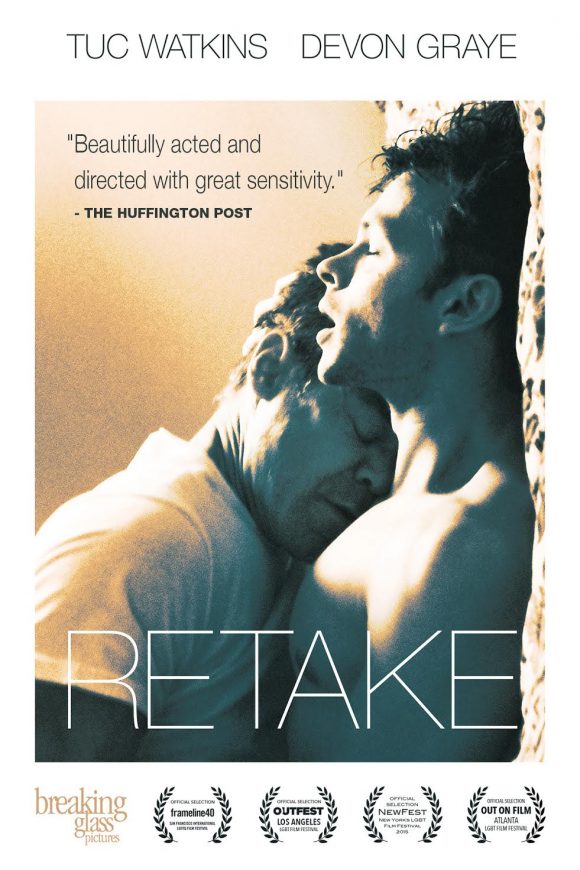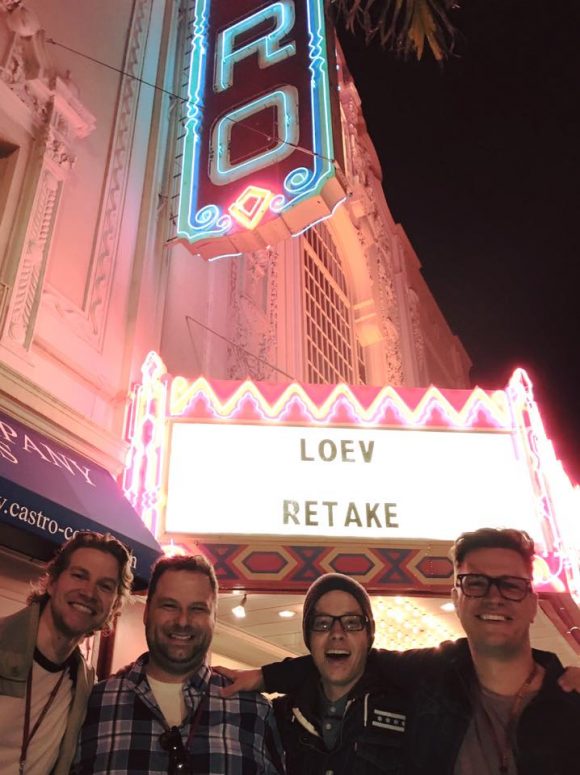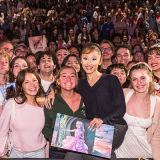How Indie Can You Get? – The Making of RETAKE
February 13, 2017
EDITOR’S NOTE: Today’s blog comes to us from alumni Nick Corporon (MFA/Directing ’09). His first feature film received a distribution deal last year, and he was kind enough to share the story of how it got made with us. This is a great piece on the trials and tribulations of indie filmmaking, and how hard work pays off.
“We should shelve this script. Just make a $30,000 feature instead of chasing money for the next
few years,” my collaborator said as we left a reading of the newest draft of our screenplay. “We
can probably get something going by next spring,” he said.
The reading of this current script went great — good performances by my perfectly cast friends,
excellent feedback on the story and characters…but one thing hung over my head. How were
we going to get the money to make this?
The thought obviously bothered my collaborator, Cinematographer/Producer/friend Collin
Brazie (MFA/Cinematography ’09), as we left the reading. We were both thinking it…but as
always, he had the guts to say it out loud.
“This script is great shape, but it’s going to take a long time to get the money to do it right. Why
don’t we do something smaller, with just two characters and shoot it for $30,000?” Collin asked.
He was right. The script we’d been working so hard on had gotten to be too ambitious.
“We could probably make two movies in the time it would take to raise the money for this one,”
Collin said.
We hugged goodbye and the thought stuck with me across many sleepless nights. Making the
first feature is like a band working on its first album — you wait for the perfect combination of
talent, energy, and hunger. You only get to make your first film once and we needed to take our
time to do it right. It wasn’t a short film. We had made enough of those.
The thought of jumping into a cheap first feature terrified me. Feature filmmaking is the big
leagues. It’s the reason we become filmmakers, so the fear of screwing up right out the gate
haunted me. But without much of a name for ourselves and no rich friends eager to invest in us,
it was going to take a long time to get the money to do the original script.
After lots of stress eating and sleepless nights, I decided that preciousness be damned. We just
should do it — be fearless and make a smaller first feature. If it was going to be a little rough
around the edges, so be it. We set aside the more ambitious project and went to work on
making a small, 2-character movie that could cost “around $30K.” Or so we thought…
The following elements came together to craft Retake: I’m a big fan of characters who are
haunted by memory. Because it was a strength in my short film work, we started there. Collin
and I, being from the Midwest, love the iconography of the desert. My short film work was
mostly LGBT-themed and I was able to turn that into some film festival success.

From there we crafted the story of Jonathan, a lonely middle-aged man who hires a male hustler
to recreate a desert road trip from his past. Retake was born. Desert + haunted memories +
LGBT content = $30,000 movie…
So where do you find $30K+ to make a movie? Our first step was to lean on the LGBT support
we had garnered from our short film work. Collin and I went to our hometowns of Kansas City,
MO and Dayton, OH and put together a movie theater full of LGBT business owners.
Armed with our short film, Barbie Boy, and a three minute sizzle reel (shot with some friends),
we pitched to them to be investors in Retake, and were able to get enough capital to start the
process.
My friend Sean Mandell hopped on board as producer, joining Mel Natnat (MFA/Producing ’11), Richie Yau (MFA/Cinematography ’09) and JC Diaz (MFA/Producing ’09).
We Kickstarted the remainder of the budget, which had grown well over $30K. Little did any of
us know that would be the hardest part. A 12-hour a day/6 days a week shooting schedule has
got nothing against the rigors of a Kickstarter campaign. It is not for the faint of heart, but
thanks to the support of the LGBT community, friends, family, and 7th grade besties, we did it.
Casting Directors Jennifer K.M. Treadwell (“Designated Survivor”) and Monica Kelly (“True
Detective”) came on board and were able to help get us Tuc Watkins (“Desperate Housewives”)
and Devon Graye (“The Flash”) in the lead roles.
To keep the budget down, we had to shoot the film in 16 and a half days. That meant most days
we had to shoot 5 pages of dialogue, sometimes 7-10 pages a day.
“Pain is temporary. Film is forever,” Robert Zemekis once said. It’s clearly true.
Editing took place in my editor Thom Newell’s dining room in the very hot summer of 2015. He
was Post Supervising the horror anthology feature Southbound (see it!) as I was working at my
day job. We’d come together at night and cut from 8pm-1am 5-6 days a week.
Once picture was locked, Yu-Ting Su (MFA/Directing ’11) took on sound design duties and
not only cleaned up a wrecked production track, but created a haunting soundscape for the
movie…in her spare bedroom. We did all of the ADR in her closet. With no AC. In August.
Yes, the entire post production process took place in a living room, spare bedroom, and now
closet. How indie can you get?
After two months of prep, three weeks of shooting, three months of editing, and a month of
sound design, we finished the movie. Our world premiere took place at the historic Castro
Theatre in San Francisco as part of the Frameline LGBT film festival to a crowd of 800 people.
It went on to play over 31 film festivals in the U.S. and a theatrical release in Los Angeles and is
now available on all major VOD platforms.

At the RETAKE premiere
If we had stayed with the original script, I fear we’d still be trying to get the money in place. I’m
so glad Collin had fortitude to recognize that while money was and will always be a hurdle…it
doesn’t have to keep you from making your first feature.
There are probably $1M, $250K, and $30K versions of most stories out there. My advice to
anyone struggling with their first feature is to just try to find the means to go out there and do it.
Get your script in the right place, set a date and do it. If you build it, they will come. Be
fearless.
You’ll notice that throughout this post I’ve been noting Chapman people. These
are my friends, collaborators that I only could have met at Dodge College. They’ve been my
support system from the time we sat next to each other in class. Retake is a testament to their
hard work and friendship. Bret Watkins and Alicia Pharris (both MFA/Cinematography ’10)
has been lighting and keeping my characters in focus since cycle films. Jeff Robinson (MFA/
Directing ’10) first AD’d, and Charlie Gibson (MFA/Cinematography ’13) key gripped
alongside John Woodside (MFA/Cinematography ’09).
As low budget and indie as our film was, the movie turned out better because of them.
“Retake” is now available on the following platforms;
Vudu: http://bit.ly/2j51Gtx
Amazon: http://amzn.to/2jflGHb
iTunes: http://apple.co/2hG6rtv
DVD: http://amzn.to/2kcCte5
Google Play: http://bit.ly/2iYP8lb
This blog post is dedicated to my dear friend Brian Patrick Carroll (MFA/Cinematography ’09)
who lost his battle with cancer on 2/3/2017. He was working on studio movies when we rolled
cameras on “Retake” or else he would have been apart of our crew. His huge heart and
fearlessness inspired us all.


